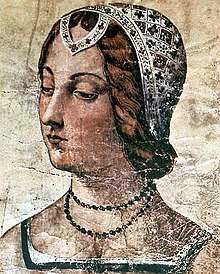Petrarch
Francesco Petrarca (Italian: [franˈtʃesko peˈtrarka]; July 20, 1304 – July 18/19, 1374), commonly anglicized as Petrarch (/ˈpiːtrɑːrk, ˈpɛt-/), was an Italian scholar and poet during the early Italian Renaissance, and one of the earliest humanists.[1]
Francesco Petrarca | |
|---|---|
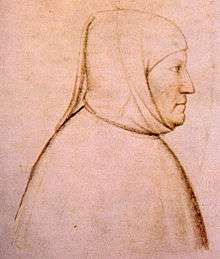 Petrarch portrait by Altichiero | |
| Born | Francesco Petracco July 20, 1304 Arezzo, Republic of Florence (now Arezzo, Tuscany, Italy) |
| Died | July 19, 1374 (aged 69) Arquà, Padua, Republic of Venice (now Padua, Italy) |
| Resting place | Arquà Petrarca |
| Occupation | Scholar, poet |
| Language | Italian, Latin |
| Nationality | Florentine |
| Alma mater | University of Montpellier University of Bologna |
| Period | Early Renaissance |
| Literary movement | Renaissance humanism |
| Notable works | Triumphs Il Canzoniere |
| Notable awards | Poet laureate of Padua |
| Partner | unknown woman or women |
| Children | Giovanni (1337–1361) Francesca (born in 1343) |
| Relatives | Eletta Canigiani (mother) Ser Petracco (father) |

Petrarch's rediscovery of Cicero's letters is often credited with initiating the 14th-century Italian Renaissance and the founding of Renaissance humanism.[2] In the 16th century, Pietro Bembo created the model for the modern Italian language based on Petrarch's works, as well as those of Giovanni Boccaccio, and, to a lesser extent, Dante Alighieri.[3] Petrarch would be later endorsed as a model for Italian style by the Accademia della Crusca.
Petrarch's sonnets were admired and imitated throughout Europe during the Renaissance and became a model for lyrical poetry. He is also known for being the first to develop the concept of the "Dark Ages."[4]
Biography
Youth and early career
Petrarch was born in the Tuscan city of Arezzo on 20 July 1304. He was the son of Ser Petracco and his wife Eletta Canigiani. His given name was Francesco Petracco, which was Latinized to Petrarca. Petrarch's younger brother was born in Incisa in Val d'Arno in 1307. Dante Alighieri was a friend of his father.[5]
Petrarch spent his early childhood in the village of Incisa, near Florence. He spent much of his early life at Avignon and nearby Carpentras, where his family moved to follow Pope Clement V, who moved there in 1309 to begin the Avignon Papacy. Petrarch studied law at the University of Montpellier (1316–20) and Bologna (1320–23) with a lifelong friend and schoolmate called Guido Sette. Because his father was in the legal profession (a notary), he insisted that Petrarch and his brother also study law. Petrarch, however, was primarily interested in writing and Latin literature and considered these seven years wasted. Additionally, he proclaimed that through legal manipulation his guardians robbed him of his small property inheritance in Florence, which only reinforced his dislike for the legal system. He protested, "I couldn't face making a merchandise of my mind," as he viewed the legal system as the art of selling justice.[5]
Petrarch was a prolific letter writer and counted Boccaccio among his notable friends to whom he wrote often. After the death of their parents, Petrarch and his brother Gherardo went back to Avignon in 1326, where he worked in numerous clerical offices. This work gave him much time to devote to his writing. With his first large-scale work, Africa, an epic in Latin about the great Roman general Scipio Africanus, Petrarch emerged as a European celebrity. On April 8, 1341, he became the second [6] poet laureate since antiquity and was crowned by Roman Senatori Giordano Orsini and Orso dell'Anguillara on the holy grounds of Rome's Capitol.[7][8][9]
He traveled widely in Europe, served as an ambassador, and (because he traveled for pleasure,[10] as with his ascent of Mont Ventoux), has been called "the first tourist".[11] During his travels, he collected crumbling Latin manuscripts and was a prime mover in the recovery of knowledge from writers of Rome and Greece. He encouraged and advised Leontius Pilatus's translation of Homer from a manuscript purchased by Boccaccio, although he was severely critical of the result. Petrarch had acquired a copy, which he did not entrust to Leontius,[12] but he knew no Greek; Petrarch said, "Homer was dumb to him, while he was deaf to Homer".[13] In 1345 he personally discovered a collection of Cicero's letters not previously known to have existed, the collection Epistulae ad Atticum, in the Chapter Library (Biblioteca Capitolare) of Verona Cathedral.[14]
Disdaining what he believed to be the ignorance of the centuries preceding the era in which he lived, Petrarch is credited or charged with creating the concept of a historical "Dark Ages".[4]
Mount Ventoux
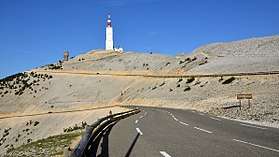
Petrarch recounts that on April 26, 1336, with his brother and two servants, he climbed to the top of Mont Ventoux (1,912 meters (6,273 ft), a feat which he undertook for recreation rather than necessity.[15] The exploit is described in a celebrated letter addressed to his friend and confessor, the monk Dionigi di Borgo San Sepolcro, composed some time after the fact. In it, Petrarch claimed to have been inspired by Philip V of Macedon's ascent of Mount Haemo and that an aged peasant had told him that nobody had ascended Ventoux before or after himself, 50 years before, and warned him against attempting to do so. The nineteenth-century Swiss historian Jacob Burckhardt noted that Jean Buridan had climbed the same mountain a few years before, and ascents accomplished during the Middle Ages have been recorded, including that of Anno II, Archbishop of Cologne.[16][17]
Scholars[18] note that Petrarch's letter[19][20] to Dionigi displays a strikingly "modern" attitude of aesthetic gratification in the grandeur of the scenery and is still often cited in books and journals devoted to the sport of mountaineering. In Petrarch, this attitude is coupled with an aspiration for a virtuous Christian life, and on reaching the summit, he took from his pocket a volume by his beloved mentor, Saint Augustine, that he always carried with him.[21]
For pleasure alone he climbed Mont Ventoux, which rises to more than six thousand feet, beyond Vaucluse. It was no great feat, of course; but he was the first recorded Alpinist of modern times, the first to climb a mountain merely for the delight of looking from its top. (Or almost the first; for in a high pasture he met an old shepherd, who said that fifty years before he had attained the summit, and had got nothing from it save toil and repentance and torn clothing.) Petrarch was dazed and stirred by the view of the Alps, the mountains around Lyons, the Rhone, the Bay of Marseilles. He took Augustine's Confessions from his pocket and reflected that his climb was merely an allegory of aspiration toward a better life.[22]
As the book fell open, Petrarch's eyes were immediately drawn to the following words:
And men go about to wonder at the heights of the mountains, and the mighty waves of the sea, and the wide sweep of rivers, and the circuit of the ocean, and the revolution of the stars, but themselves they consider not.[19]
Petrarch's response was to turn from the outer world of nature to the inner world of "soul":
I closed the book, angry with myself that I should still be admiring earthly things who might long ago have learned from even the pagan philosophers that nothing is wonderful but the soul, which, when great itself, finds nothing great outside itself. Then, in truth, I was satisfied that I had seen enough of the mountain; I turned my inward eye upon myself, and from that time not a syllable fell from my lips until we reached the bottom again. ... [W]e look about us for what is to be found only within. ... How many times, think you, did I turn back that day, to glance at the summit of the mountain which seemed scarcely a cubit high compared with the range of human contemplation[19]
James Hillman argues that this rediscovery of the inner world is the real significance of the Ventoux event.[23] The Renaissance begins not with the ascent of Mont Ventoux but with the subsequent descent—the "return [...] to the valley of soul", as Hillman puts it. Arguing against such a singular and hyperbolic periodization, Paul James suggests a different reading:
In the alternative argument that I want to make, these emotional responses, marked by the changing senses of space and time in Petrarch’s writing, suggest a person caught in unsettled tension between two different but contemporaneous ontological formations: the traditional and the modern.[24]
Later years
Petrarch spent the later part of his life journeying through northern Italy as an international scholar and poet-diplomat. His career in the Church did not allow him to marry, but he is believed to have fathered two children by a woman or women unknown to posterity. A son, Giovanni, was born in 1337, and a daughter, Francesca, was born in 1343. He later legitimized both.[25]
Giovanni died of the plague in 1361. In the same year Petrarch was named canon in Monselice near Padua. Francesca married Francescuolo da Brossano (who was later named executor of Petrarch's will) that same year. In 1362, shortly after the birth of a daughter, Eletta (the same name as Petrarch's mother), they joined Petrarch in Venice to flee the plague then ravaging parts of Europe. A second grandchild, Francesco, was born in 1366, but died before his second birthday. Francesca and her family lived with Petrarch in Venice for five years from 1362 to 1367 at Palazzo Molina; although Petrarch continued to travel in those years. Between 1361 and 1369 the younger Boccaccio paid the older Petrarch two visits. The first was in Venice, the second was in Padua.
About 1368 Petrarch and his daughter Francesca (with her family) moved to the small town of Arquà in the Euganean Hills near Padua, where he passed his remaining years in religious contemplation. He died in his house in Arquà early on July 20, 1374—his seventieth birthday. The house hosts now a permanent exhibition of Petrarchian works and curiosities; inside is the famous tomb of Petrarch's beloved cat who was embalmed, among other objects. On the marble slab there is a Latin inscription written by Antonio Quarenghi:
Etruscus gemino vates ardebat amore:
Maximus ignis ego; Laura secundus erat.
Quid rides? divinæ illam si gratia formæ,
Me dignam eximio fecit amante fides.
Si numeros geniumque sacris dedit illa libellis
Causa ego ne sævis muribus esca forent.
Arcebam sacro vivens a limine mures,
Ne domini exitio scripta diserta forent;
Incutio trepidis eadem defuncta pavorem,
Et viget exanimi in corpore prisca fides.[26]
Petrarch's will (dated April 4, 1370) leaves 50 florins to Boccaccio "to buy a warm winter dressing gown"; various legacies (a horse, a silver cup, a lute, a Madonna) to his brother and his friends; his house in Vaucluse to its caretaker; for his soul, and for the poor; and the bulk of his estate to his son-in-law, Francescuolo da Brossano, who is to give half of it to "the person to whom, as he knows, I wish it to go"; presumably his daughter, Francesca, Brossano's wife. The will mentions neither the property in Arquà nor his library; Petrarch's library of notable manuscripts was already promised to Venice, in exchange for the Palazzo Molina. This arrangement was probably cancelled when he moved to Padua, the enemy of Venice, in 1368. The library was seized by the lords of Padua, and his books and manuscripts are now widely scattered over Europe.[27] Nevertheless, the Biblioteca Marciana traditionally claimed this bequest as its founding, although it was in fact founded by Cardinal Bessarion in 1468.[28]
Works
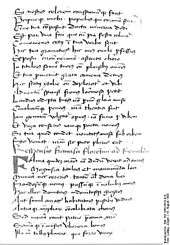

Illuminated manuscript by Simone Martini, 29 x 20 cm Biblioteca Ambrosiana, Milan.
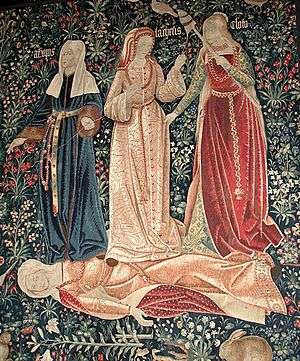
Petrarch is best known for his Italian poetry, notably the Rerum vulgarium fragmenta ("Fragments of Vernacular Matters"), a collection of 366 lyric poems in various genres also known as 'canzoniere' ('songbook'), and the Triumphi ("Triumphs"), a six-part narrative poem of Dantean inspiration. However, Petrarch was an enthusiastic Latin scholar and did most of his writing in this language. His Latin writings include scholarly works, introspective essays, letters, and more poetry. Among them are Secretum ("My Secret Book"), an intensely personal, imaginary dialogue with a figure inspired by Augustine of Hippo; De Viris Illustribus ("On Famous Men"), a series of moral biographies; Rerum Memorandarum Libri, an incomplete treatise on the cardinal virtues; De Otio Religiosorum ("On Religious Leisure")[29] and De Vita Solitaria ("On the Solitary Life"), which praise the contemplative life; De Remediis Utriusque Fortunae ("Remedies for Fortune Fair and Foul"), a self-help book which remained popular for hundreds of years; Itinerarium ("Petrarch's Guide to the Holy Land"); invectives against opponents such as doctors, scholastics, and the French; the Carmen Bucolicum, a collection of 12 pastoral poems; and the unfinished epic Africa. He translated seven psalms, a collection known as the Penitential Psalms.[30]
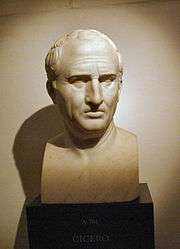
Petrarch also published many volumes of his letters, including a few written to his long-dead friends from history such as Cicero and Virgil. Cicero, Virgil, and Seneca were his literary models. Most of his Latin writings are difficult to find today, but several of his works are available in English translations. Several of his Latin works are scheduled to appear in the Harvard University Press series I Tatti.[31] It is difficult to assign any precise dates to his writings because he tended to revise them throughout his life.
Petrarch collected his letters into two major sets of books called Rerum familiarum liber ("Letters on Familiar Matters") and Seniles ("Letters of Old Age"), both of which are available in English translation.[32] The plan for his letters was suggested to him by knowledge of Cicero's letters. These were published "without names" to protect the recipients, all of whom had close relationships to Petrarch. The recipients of these letters included Philippe de Cabassoles, bishop of Cavaillon; Ildebrandino Conti, bishop of Padua; Cola di Rienzo, tribune of Rome; Francesco Nelli, priest of the Prior of the Church of the Holy Apostles in Florence; and Niccolò di Capoccia, a cardinal and priest of Saint Vitalis. His "Letter to Posterity" (the last letter in Seniles)[33] gives an autobiography and a synopsis of his philosophy in life. It was originally written in Latin and was completed in 1371 or 1372—the first such autobiography in a thousand years (since Saint Augustine).[34][35]
While Petrarch's poetry was set to music frequently after his death, especially by Italian madrigal composers of the Renaissance in the 16th century, only one musical setting composed during Petrarch's lifetime survives. This is Non al suo amante by Jacopo da Bologna, written around 1350.
Laura and poetry
On April 6, 1327,[36] after Petrarch gave up his vocation as a priest, the sight of a woman called "Laura" in the church of Sainte-Claire d'Avignon awoke in him a lasting passion, celebrated in the Rerum vulgarium fragmenta ("Fragments of Vernacular Matters"). Laura may have been Laura de Noves, the wife of Count Hugues de Sade (an ancestor of the Marquis de Sade). There is little definite information in Petrarch's work concerning Laura, except that she is lovely to look at, fair-haired, with a modest, dignified bearing. Laura and Petrarch had little or no personal contact. According to his "Secretum", she refused him because she was already married. He channeled his feelings into love poems that were exclamatory rather than persuasive, and wrote prose that showed his contempt for men who pursue women. Upon her death in 1348, the poet found that his grief was as difficult to live with as was his former despair. Later in his "Letter to Posterity", Petrarch wrote: "In my younger days I struggled constantly with an overwhelming but pure love affair—my only one, and I would have struggled with it longer had not premature death, bitter but salutary for me, extinguished the cooling flames. I certainly wish I could say that I have always been entirely free from desires of the flesh, but I would be lying if I did".
While it is possible she was an idealized or pseudonymous character—particularly since the name "Laura" has a linguistic connection to the poetic "laurels" Petrarch coveted—Petrarch himself always denied it. His frequent use of l'aura is also remarkable: for example, the line "Erano i capei d'oro a l'aura sparsi" may both mean "her hair was all over Laura's body", and "the wind ("l'aura") blew through her hair". There is psychological realism in the description of Laura, although Petrarch draws heavily on conventionalised descriptions of love and lovers from troubadour songs and other literature of courtly love. Her presence causes him unspeakable joy, but his unrequited love creates unendurable desires, inner conflicts between the ardent lover and the mystic Christian, making it impossible to reconcile the two. Petrarch's quest for love leads to hopelessness and irreconcilable anguish, as he expresses in the series of paradoxes in Rima 134 "Pace non trovo, et non ò da far guerra;/e temo, et spero; et ardo, et son un ghiaccio": "I find no peace, and yet I make no war:/and fear, and hope: and burn, and I am ice".[37]
Laura is unreachable and evanescent – descriptions of her are evocative yet fragmentary.Francesco De Sanctis on the powerful music of his verse in his Storia della letteratura italiana. Gianfranco Contini, in a famous essay ("Preliminari sulla lingua del Petrarca". Petrarca, Canzoniere. Turin, Einaudi, 1964) has described Petrarch's language in terms of "unilinguismo" (contrasted with Dantean "plurilinguismo").
Sonnet 227
| Original Italian[38] | English translation by A.S. Kline[39] |
|---|---|
|
Aura che quelle chiome bionde et crespe |
Breeze, blowing that blonde curling hair, |
Dante
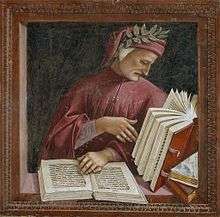
Petrarch is a world apart from Dante and his Divina Commedia. In spite of the metaphysical subject, the Commedia is deeply rooted in the cultural and social milieu of turn-of-the-century Florence: Dante's rise to power (1300) and exile (1302); his political passions call for a "violent" use of language, where he uses all the registers, from low and trivial to sublime and philosophical. Petrarch confessed to Boccaccio that he had never read the Commedia, remarks Contini, wondering whether this was true or Petrarch wanted to distance himself from Dante. Dante's language evolves as he grows old, from the courtly love of his early stilnovistic Rime and Vita nuova to the Convivio and Divina Commedia, where Beatrice is sanctified as the goddess of philosophy—the philosophy announced by the Donna Gentile at the death of Beatrice.[40]
In contrast, Petrarch's thought and style are relatively uniform throughout his life—he spent much of it revising the songs and sonnets of the Canzoniere rather than moving to new subjects or poetry. Here, poetry alone provides a consolation for personal grief, much less philosophy or politics (as in Dante), for Petrarch fights within himself (sensuality versus mysticism, profane versus Christian literature), not against anything outside of himself. The strong moral and political convictions which had inspired Dante belong to the Middle Ages and the libertarian spirit of the commune; Petrarch's moral dilemmas, his refusal to take a stand in politics, his reclusive life point to a different direction, or time. The free commune, the place that had made Dante an eminent politician and scholar, was being dismantled: the signoria was taking its place. Humanism and its spirit of empirical inquiry, however, were making progress—but the papacy (especially after Avignon) and the empire (Henry VII, the last hope of the white Guelphs, died near Siena in 1313) had lost much of their original prestige.[41]
Petrarch polished and perfected the sonnet form inherited from Giacomo da Lentini and which Dante widely used in his Vita nuova to popularise the new courtly love of the Dolce Stil Novo. The tercet benefits from Dante's terza rima (compare the Divina Commedia), the quatrains prefer the ABBA–ABBA to the ABAB–ABAB scheme of the Sicilians. The imperfect rhymes of u with closed o and i with closed e (inherited from Guittone's mistaken rendering of Sicilian verse) are excluded, but the rhyme of open and closed o is kept. Finally, Petrarch's enjambment creates longer semantic units by connecting one line to the following. The vast majority (317) of Petrarch's 366 poems collected in the Canzoniere (dedicated to Laura) were sonnets, and the Petrarchan sonnet still bears his name.[42]
Philosophy


Petrarch is traditionally called the father of Humanism and considered by many to be the "father of the Renaissance."[43] In his work Secretum meum he points out that secular achievements did not necessarily preclude an authentic relationship with God. Petrarch argued instead that God had given humans their vast intellectual and creative potential to be used to their fullest.[44] He inspired humanist philosophy which led to the intellectual flowering of the Renaissance. He believed in the immense moral and practical value of the study of ancient history and literature—that is, the study of human thought and action. Petrarch was a devout Catholic and did not see a conflict between realizing humanity's potential and having religious faith.
A highly introspective man, he shaped the nascent humanist movement a great deal because many of the internal conflicts and musings expressed in his writings were seized upon by Renaissance humanist philosophers and argued continually for the next 200 years. For example, Petrarch struggled with the proper relation between the active and contemplative life, and tended to emphasize the importance of solitude and study. In a clear disagreement with Dante, in 1346 Petrarch argued in his De vita solitaria that Pope Celestine V's refusal of the papacy in 1294 was as a virtuous example of solitary life.[45] Later the politician and thinker Leonardo Bruni (1370–1444) argued for the active life, or "civic humanism". As a result, a number of political, military, and religious leaders during the Renaissance were inculcated with the notion that their pursuit of personal fulfillment should be grounded in classical example and philosophical contemplation.[46]
Legacy
Petrarch's influence is evident in the works of Serafino Ciminelli from Aquila (1466–1500) and in the works of Marin Držić (1508–1567) from Dubrovnik.[47]
The Romantic composer Franz Liszt set three of Petrarch's Sonnets (47, 104, and 123) to music for voice, Tre sonetti del Petrarca, which he later would transcribe for solo piano for inclusion in the suite Années de Pèlerinage. Liszt also set a poem by Victor Hugo, " O quand je dors" in which Petrarch and Laura are invoked as the epitome of erotic love.
While in Avignon in 1991, Modernist composer Elliott Carter completed his solo flute piece Scrivo in Vento which is in part inspired by and structured by Petrarch's Sonnet 212, Beato in sogno. It was premiered on Petrarch's 687th birthday.[48]
In November 2003, it was announced that pathological anatomists would be exhuming Petrarch's body from his casket in Arquà Petrarca, in order to verify 19th-century reports that he had stood 1.83 meters (about six feet), which would have been tall for his period. The team from the University of Padua also hoped to reconstruct his cranium in order to generate a computerized image of his features to coincide with his 700th birthday. The tomb had been opened previously in 1873 by Professor Giovanni Canestrini, also of Padua University. When the tomb was opened, the skull was discovered in fragments and a DNA test revealed that the skull was not Petrarch's,[49] prompting calls for the return of Petrarch's skull.
The researchers are fairly certain that the body in the tomb is Petrarch's due to the fact that the skeleton bears evidence of injuries mentioned by Petrarch in his writings, including a kick from a donkey when he was 42.[50]
Works in English translation
- Francesco Petrarch, Letters on Familiar Matters (Rerum familiarium libri), translated by Aldo S. Bernardo (New York: Italica Press, 2005). Volume 1, Books 1–8; Volume 2, Books 9–16; Volume 3, Books 17–24
- Francesco Petrarch, Letters of Old Age (Rerum senilium libri), translated by Aldo S. Bernardo, Saul Levin & Reta A. Bernardo (New York: Italica Press, 2005). Volume 1, Books 1–9; Volume 2, Books 10–18
- Francesco Petrarch, My Secret Book, (Secretum), translated by Nicholas Mann. Harvard University Press
- Francesco Petrarch, On Religious Leisure (De otio religioso), edited & translated by Susan S. Schearer, introduction by Ronald G. Witt (New York: Italica Press, 2002)
- Francesco Petrarch, The Revolution of Cola di Rienzo, translated from Latin and edited by Mario E. Cosenza; 3rd, revised, edition by Ronald G. Musto (New York; Italica Press, 1996)
- Francesco Petrarch, Selected Letters, vol. 1 and 2, translated by Elaine Fantham. Harvard University Press
See also
Notes
- Rico, Francisco; Marcozzi, Luca (2015). "Petrarca, Francesco". Dizionario Biografico degli Italiani (in Italian). 82. Istituto dell'Enciclopedia Italiana.
- This designation appears, for instance, in a recent review of Carol Quillen's Rereading the Renaissance.
- In the Prose della volgar lingua, Bembo proposes Petrarch and Boccaccio as models of Italian style, while expressing reservations about emulating Dante's usage.
- Renaissance or Prenaissance, Journal of the History of Ideas, Vol. 4, No. 1. (Jan. 1943), pp. 69–74; Theodore E. Mommsen, "Petrarch's Conception of the 'Dark Ages'" Speculum 17.2 (April 1942: 226–242); JSTOR link to a collection of several letters in the same issue.
- J.H. Plumb, The Italian Renaissance, 1961; Chapter XI by Morris Bishop "Petrarch", pp. 161–175; New York, American Heritage Publishing, ISBN 0-618-12738-0
- after "Albertino Mussato" who was the first to be so crowned according to Robert Weiss, The Renaissance Discovery of Classical Antiquity (Oxford, 1973)
- Plumb, p. 164
- Pietrangeli (1981), p. 32
- Kirkham, Victoria (2009). Petrarch: A Critical Guide to the Complete Works. Chicago: University of Chicago Press. p. 9. ISBN 978-0226437439.
- Bishop, Morris Petrarch and his World, p. 92, Indiana University Press 1963, ISBN 0-8046-1730-9
- NSA Family Encyclopedia, Petrarch, Francesco, Vol. 11, p. 240, Standard Education Corp. 1992
- Vittore Branca, Boccaccio; The Man and His Works, tr. Richard Monges, pp. 113–118
- Ep. Fam. 18.2 §9
- "History – Biblioteca Capitolare Verona".
- Nicolson, Marjorie Hope; Mountain Gloom and Mountain Glory: The Development of the Aesthetics of the Infinite (1997), p. 49; ISBN 0-295-97577-6
- Burckhardt, Jacob. The Civilisation of the Period of the Renaissance in Italy (1860). Translated by S.G.C. Middlemore. Swan Sonnenschein (1904), pp. 301–302.
- Lynn Thorndike, Renaissance or Prenaissance, Journal of the History of Ideas, Vol. 4, No. 1. (Jan. 1943), pp. 69–74. JSTOR link to a collection of several letters in the same issue.
- Such as J.H. Plumb, in his book The Italian Renaissance,
- Familiares 4.1 translated by Morris Bishop, quoted in Plumb.
- Asher, Lyell (1993). "Petrarch at the Peak of Fame". PMLA. 108 (5): 1050–1063. doi:10.2307/462985. JSTOR 462985.
- McLaughlin, Edward Tompkins; Studies in Medieval Life and Literature, p. 6, New York: G.P. Putnam's Sons, 1894
- Plumb, J.H. (1961). The Horizon Book of the Renaissance. New York: American Heritage. p. 26.
- Hillman, James (1977). Revisioning Psychology. Harper & Row. pp. 197. ISBN 978-0-06-090563-7.
- James, Paul (Spring 2014). "Emotional Ambivalence across Times and Spaces: Mapping Petrarch's Intersecting Worlds". Exemplaria. 26 (1): 82. doi:10.1179/1041257313Z.00000000044. Retrieved August 4, 2015.
- Plumb, p. 165
- The last lay of Petrarch's cat, Notes and Queries, Vol. V, Number 121, February 21, 1852, Author: Various, Editor: George Bell
- Bishop, pp. 360, 366. Francesca and the quotes from there; Bishop adds that the dressing-gown was a piece of tact: "fifty florins would have bought twenty dressing-gowns".
- Tedder, Henry Richard; Brown, James Duff (1911). . In Chisholm, Hugh (ed.). Encyclopædia Britannica. 16 (11th ed.). Cambridge University Press. p. 573.
- Francesco Petrarch, On Religious Leisure (De otio religioso), edited & translated by Susan S. Schearer, introduction by Ronald G. Witt (New York: Italica Press, 2002).
- Sturm-Maddox, Sara (2010). Petrarch's Laurels. Pennsylvania State UP. p. 153. ISBN 978-0271040745.
- "I Tatti Renaissance Library/Forthcoming and Published Volumes". Hup.harvard.edu. Retrieved July 31, 2009.
- Letters on Familiar Matters (Rerum familiarium libri), translated by Aldo S. Bernardo, 3 vols.' and Letters of Old Age (Rerum senilium libri), translated by Aldo S. Bernardo, Saul Levin & Reta A. Bernardo, 2 vols.
- Petrarch's Letter to Posterity (1909 English translation, with notes, by James Harvey Robinson)
- Wilkins Ernest H (1964). "On the Evolution of Petrarch's Letter to Posterity". Speculum. 39 (2): 304–308. doi:10.2307/2852733. JSTOR 2852733.
- Plumb, p. 173
- April 6, 1327 is often thought to be Good Friday based on poems 3 and 211 of Petrarch's Rerum vulgarium fragmenta, but in fact that date fell on Monday in 1327. The apparent explanation is that Petrarch was not referring to the variable date of Good Friday but to the date fixed by the death of Christ in absolute time, which at the time was thought to be April 6 (Mark Musa, Petrarch's Canzoniere, Indiana University Press, 1996, p. 522).
- "Petrarch (1304–1374). The Complete Canzoniere: 123–183". www.poetryintranslation.com.
- "Canzoniere (Rerum vulgarium fragmenta)/Aura che quelle chiome bionde et crespe - Wikisource".
- "Petrarch (1304–1374) - the Complete Canzoniere: 184-244".
- "Archived copy" (PDF). Archived from the original (PDF) on November 12, 2013. Retrieved December 28, 2013.CS1 maint: archived copy as title (link)
- "The Oregon Petrarch Open Book – "Petrarch is again in sight"". petrarch.uoregon.edu.
- "Movements : Poetry through the Ages". www.webexhibits.org.
- See for example Rudolf Pfeiffer, History of Classical Scholarship 1300–1850, Oxford University Press, 1976, p. 1; Gilbert Highet, The Classical Tradition, Oxford University Press, 1949, p. 81–88.
- Famous First Facts International, H.W. Wilson Company, New York 2000, ISBN 0-8242-0958-3, p. 303, item 4567.
- Petrarca, Francesco (1879). De vita Solitaria (in Italian). Bologna: Gaetano Romagnoli.
- "Edizioni Ghibli, Il Rinascimento e Petrarca" (in Italian). edizionighibli.com. August 18, 2016. Retrieved September 6, 2019.
- Encyclopedia of the Renaissance: Class-Furió Ceriol, Vol. 2, p. 106, Paul F. Grendler, Renaissance Society of America, Scribner's published in association with the Renaissance Society of America, 1999. ISBN 978-0-684-80509-2
- Spencer, Patricia (2008) "Regarding Scrivo in Vento: A Conversation with Elliott Carter" Flutest Quarterly summer.
- Caramelli D, Lalueza-Fox C, Capelli C, et al. (November 2007). "Genetic analysis of the skeletal remains attributed to Francesco Petrarch". Forensic Sci. Int. 173 (1): 36–40. doi:10.1016/j.forsciint.2007.01.020. PMID 17320326.
- "UPF.edu" (PDF). Archived from the original (PDF) on March 6, 2009. Retrieved March 1, 2009.
References
- Bartlett, Kenneth R. (1992). The Civilization of the Italian Renaissance; a Source Book. Lexington: D.C. Heath and Company. ISBN 0-669-20900-7
- Bishop, Morris (1961). "Petrarch." In J. H. Plumb (Ed.), Renaissance Profiles, pp. 1–17. New York: Harper & Row. ISBN 0-06-131162-6 .
- Hanawalt, A. Barbara (1998). The Middle Ages: An Illustrated History pp. 131–132 New York: Oxford University Press
- James, Paul (2014). "Emotional Ambivalence across Times and Spaces: Mapping Petrarch's Intersecting Worlds". Exemplaria. 26 (1): 81–104. doi:10.1179/1041257313z.00000000044.
- Kallendorf, Craig. "The Historical Petrarch," The American Historical Review, Vol. 101, No. 1 (Feb. 1996): 130–141.
Further reading
- Bernardo, Aldo (1983). "Petrarch." In Dictionary of the Middle Ages, volume 9
- Celenza, Christopher S. (2017). Petrarch: Everywhere a Wanderer. London: Reaktion. ISBN 978-1780238388
- Hennigfeld, Ursula (2008). Der ruinierte Körper. Petrarkistische Sonette in transkultureller Perspektive. Würzburg, Königshausen & Neumann, 2008, ISBN 978-3-8260-3768-9
- Hollway-Calthrop, Henry (1907). Petrarch: His Life and Times, Methuen. From Google Books
- Kohl, Benjamin G. (1978). "Francesco Petrarch: Introduction; How a Ruler Ought to Govern His State," in The Earthly Republic: Italian Humanists on Government and Society, ed. Benjamin G. Kohl and Ronald G. Witt, 25–78. Philadelphia: University of Pennsylvania Press. ISBN 0-8122-1097-2
- Nauert, Charles G. (2006). Humanism and the Culture of Renaissance Europe: Second Edition. Cambridge: Cambridge University Press. ISBN 0-521-54781-4
- Rawski, Conrad H. (1991). Petrarch's Remedies for Fortune Fair and Foul A Modern English Translation of De remediis utriusque Fortune, with a Commentary. ISBN 0-253-34849-8
- Robinson, James Harvey (1898). Petrarch, the First Modern Scholar and Man of Letters Harvard University
- Kirkham, Victoria and Armando Maggi (2009). Petrarch: A Critical Guide to the Complete Works. University of Chicago Press. ISBN 978-0-226-43741-5.
- A. Lee, Petrarch and St. Augustine: Classical Scholarship, Christian Theology and the Origins of the Renaissance in Italy, Brill, Leiden, 2012, ISBN 978-9004224032
- N. Mann, Petrarca [Ediz. orig. Oxford University Press (1984)] – Ediz. ital. a cura di G. Alessio e L. Carlo Rossi – Premessa di G. Velli, LED Edizioni Universitarie, Milano, 1993, ISBN 88-7916-021-4
- Il Canzoniere» di Francesco Petrarca. La Critica Contemporanea, G. Barbarisi e C. Berra (edd.), LED Edizioni Universitarie, Milano, 1992, ISBN 88-7916-005-2
- G. Baldassari, Unum in locum. Strategie macrotestuali nel Petrarca politico, LED Edizioni Universitarie, Milano, 2006, ISBN 88-7916-309-4
- Francesco Petrarca, Rerum vulgarium Fragmenta. Edizione critica di Giuseppe Savoca, Olschki, Firenze, 2008, ISBN 978-88-222-5744-4
- Plumb, J. H., The Italian Renaissance, Houghton Mifflin, 2001, ISBN 0-618-12738-0
- Giuseppe Savoca, Il Canzoniere di Petrarca. Tra codicologia ed ecdotica, Olschki, Firenze, 2008, ISBN 978-88-222-5805-2
- Roberta Antognini, Il progetto autobiografico delle "Familiares" di Petrarca, LED Edizioni Universitarie, Milano, 2008, ISBN 978-88-7916-396-5
- Paul Geyer und Kerstin Thorwarth (hg), Petrarca und die Herausbildung des modernen Subjekts (Göttingen, Vandenhoeck & Ruprecht, 2009) (Gründungsmythen Europas in Literatur, Musik und Kunst, 2)
External links
- Petrarch and his Cat Muse
- Petrarch from the Catholic Encyclopedia
- Excerpts from his works and letters
- Francesco Petrarca (Petrarch) (1304-1374)
- Works by Petrarch at Project Gutenberg
- Works by or about Francesco Petrarca at Internet Archive
- Works by or about Petrarch at Internet Archive
- Works by Petrarch at LibriVox (public domain audiobooks)

- Timeline of life of Petrarch
- Poems From The Canzoniere, translated by Tony Kline.
- Francesco Petrarch at The Online Library of Liberty
- De remediis utriusque fortunae, Cremonae, B. de Misintis ac Caesaris Parmensis, 1492. (Vicifons)
- Free scores of works by Petrarch in the Choral Public Domain Library (ChoralWiki)
- Petrarch and Laura Multi-lingual site including translated works in the public domain and biography, pictures, music.
- Petrarch - the poet who lost his head April 2004 article in The Guardian regarding the exhumation of Petrarch's remains
- Oregon Petrarch Open Book – A working database-driven hypertext in and around Francis Petrarch's Rerum Vulgarium Fragmenta (Canzoniere)
- Historia Griseldis From the Rare Book and Special Collections Division at the Library of Congress
- Francesco Petrarch, De viris illustribus, digitized French codex, at Somni

